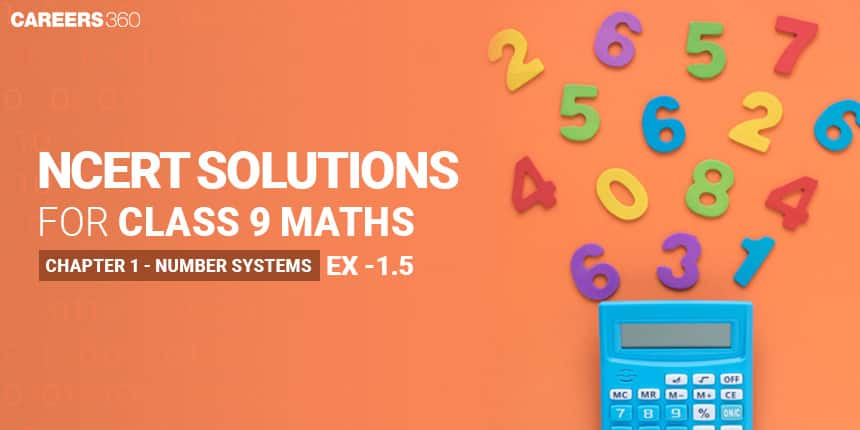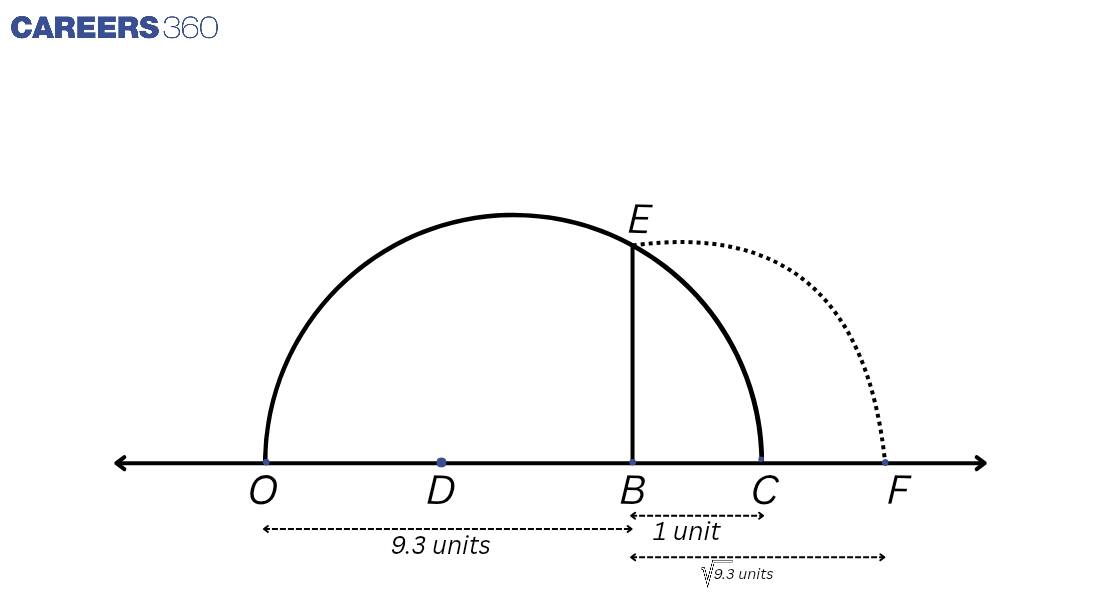NCERT Solutions for Class 9 Maths Chapter 1 Exercise 1.4 - Number Systems
A number that can be broken down into parts and addressed as $\frac{p}{q}$, where p and q are integers and q ≠ 0 are rational number. Irrational numbers are numbers that can't be stated as fractions with numbers in the numerator and denominator. Mathematically, numbers are labelled into many units, particularly rational, irrational, natural, whole, integer, and real numbers. Class 9 Maths exercise 1.4 deals with the concepts of the types of numbers into rational and irrational numbers, as well as the use of certain mathematical operations. Real numbers are the combination of rational and irrational numbers, which might have positive or negative attributes.
This Story also Contains
- NCERT Solutions for Class 9 Maths Chapter 1 – Number Systems Exercise 1.4
- Access Number Systems Class 9 Chapter 1 Exercise: 1.4
- Topics Covered in Chapter 1 Number System: Exercise 1.4
- NCERT Solutions of Class 9 Subject Wise
- NCERT Subject-Wise Exemplar Solutions

NCERT Solutions for Class 9 Maths Chapter 1 exercise 1.4 include five questions, where four are lengthy and the remaining 1 among them is a brief solution which is based on the category of determining the numbers into rational and irrational numbers by using certain mathematical operations and the illustration of given numbers on the number line. The concepts associated with the number lines and mathematical operations are nicely defined in this Class 9 Maths chapter 1 exercise 1.4. The following exercises are also present, along with Class 9 Maths Chapter 1 exercise 1.4. The 9th class maths exercise 1.4 answers are authored by Subject Matter Experts in straightforward language by covering all the questions according to the latest syllabus and by following the NCERT guidelines, ensuring ease of understanding. Additionally, they are accessible in PDF format, allowing students to download and utilise them conveniently. Students can also go through the NCERT Books for different standards.
Access Number Systems Class 9 Chapter 1 Exercise: 1.4
Q1 (i) Classify the following numbers as rational or irrational: $2-\sqrt{5}$
Solution:
Value of $\sqrt{5}$ is 2.23606798....
Now,
$\Rightarrow 2 - \sqrt{5} = 2 - 2.23606798... = -0.23606798...$
Since the number is non-terminating and non-recurring. Therefore, it is an irrational number.
Q1 (ii) Classify the following numbers as rational or irrational: $\left ( 3+\sqrt{23} \right )-\sqrt{23}$
Solution:
Given number is $\left ( 3+\sqrt{23} \right )-\sqrt{23}$
$\Rightarrow \left ( 3+\sqrt{23} \right )-\sqrt{23}$
$\Rightarrow$ $3+\sqrt{23} - \sqrt{23} = 3$
Now, it is a rational number because we can represent it in the form of $\frac{p}{q}$
Q1 (iii) Classify the following numbers as rational or irrational: $\frac{2\sqrt{7}}{7\sqrt{7}}$
Solution:
Given number is $\frac{2\sqrt{7}}{7\sqrt{7}}$
$\Rightarrow \frac{2\sqrt{7}}{7\sqrt{7}} = \frac{2}{7}$
As we can see that the number is in $\frac{p}{q}$ form. Therefore, it is a rational number.
Q1 (iv) Classify the following numbers as rational or irrational: $\frac{1}{\sqrt{2}}$
Solution:
Given number is $\frac{1}{\sqrt{2}}$
After parameterising the denominator, we get,
$\Rightarrow \frac{1}{\sqrt{2}}= \frac{\sqrt{2}}{2}=\frac{1.41421356..}{2} =0.7071068...$
Clearly, the decimal expansion of this expression is non-terminating and non-recurring. Therefore, it is an irrational number.
Q1 (v) Classify the following numbers as rational or irrational: $2\pi$
Solution:
Given number is $2\pi$
We know that the value of $\pi = 3.14159265...$
Now,
$\Rightarrow 2\pi = 2\times 3.14159265... = 6.2831853...$
Clearly, as the decimal expansion of this expression is non-terminating and
non-recurring. Therefore, it is an irrational number.
Q2 (i) Simplify each of the following expressions: $(3+\sqrt{3})(2+\sqrt{2})$
Solution:
Given number is $(3+\sqrt{3})(2+\sqrt{2})$
Now, we will reduce it to
$\Rightarrow (3+\sqrt{3})(2+\sqrt{2})= 3 × 2+3 × \sqrt{2}+\sqrt{3} × 2+\sqrt{3} × \sqrt{2}$
$= 6+3\sqrt{2}+2\sqrt{3}+\sqrt{6}$
Therefore, answer is $6+3\sqrt{2}+2\sqrt{3}+\sqrt{6}$
Q2 (ii) Simplify each of the following expressions: $\left (3+\sqrt{3} \right )\left ( 3-\sqrt{3} \right )$
Solution:
Given number is $\left (3+\sqrt{3} \right )\left ( 3-\sqrt{3} \right )$
Now, we will reduce it to
$\Rightarrow (3+\sqrt{3})(3-\sqrt{3})= \left ( (3)^2-(\sqrt{3})^2 \right )$ $\left (Using \ (a+b)(a-b)=a^2-b^2 \right)$
$= 9 - 3 = 6$
Therefore, the answer is 6.
Q2 (iii) Simplify each of the following expressions: $\left (\sqrt{5}+\sqrt{2} \right )^{2}$
Solution:
Given number is $\left (\sqrt{5}+\sqrt{2} \right )^{2}$
Now, we will reduce it to
$\Rightarrow \left (\sqrt{5}+\sqrt{2} \right )^{2}= \left ( (\sqrt{5})^2+ (\sqrt{2})^2+2 ×\sqrt{5} × \sqrt{2} \right )$ $\left ( Using \ (a+b)^2=a^2+b^2 +2ab\right )$
$=5+2+2\sqrt{10}$
$=7+2\sqrt{10}$
Therefore, the answer is $7+2\sqrt{10}$
Solution:
Given number is $\left (\sqrt{5}-\sqrt{2} \right )\left ( \sqrt{5}+\sqrt{2} \right )$
Now, we will reduce it to
$\Rightarrow \left (\sqrt{5}-\sqrt{2} \right )\left ( \sqrt{5}+\sqrt{2} \right )= \left ( (\sqrt{5})^2-(\sqrt{2})^2 \right )$ $\left (Using \ (a+b)(a-b)=a^2-b^2\right )$
$=5-2$
$=3$
Therefore, the answer is 3.
Solution:
There is no contradiction.
When we measure a length with a scale or any other instrument, we only obtain an approximate rational value. We never obtain an exact value.
For this reason, we cannot say that either c or d is irrational.
Therefore, the fraction $\frac{c}{d}$ is irrational. So, the value of $\pi$ is approximately equal to $\frac{22}{7} = 3.142857....$
Therefore, $\pi$ is irrational.
Q4 Represent $\sqrt{9.3}$ on the number line.
Solution:
Draw a line segment OB of 9.3 units. Then, extend it to C so that BC = 1 unit. Find the mid-point D of OC and draw a semicircle on OC while taking D as its centre and OD as the radius. Now, draw a perpendicular to line OC passing through point B and intersecting the semi-circle at E. Now, take B as the centre and BE as radius, draw an arc intersecting the number line at F. The length BF is $9\sqrt{3}$ units.
Q5 (i) Rationalise the denominators of the following: $\frac{1}{\sqrt{7}}$
Solution:
Given number is $\frac{1}{\sqrt{7}}$
Now, on rationalisation, we will get
$\Rightarrow \frac{1}{\sqrt 7} = \frac{1}{\sqrt 7}\times \frac{\sqrt 7}{\sqrt 7 } = \frac{\sqrt7}{7}$
Therefore, the answer is $\frac{\sqrt7}{7}$
Q5 (ii) Rationalise the denominators of the following: $\frac{1}{\sqrt{7}-\sqrt{6}}$
Solution:
Given number is $\frac{1}{\sqrt{7}-\sqrt{6}}$
Now, on rationalisation, we will get
$\Rightarrow \frac{1}{\sqrt 7-\sqrt6} = \frac{1}{\sqrt 7-\sqrt 6}\times \frac{\sqrt 7+\sqrt 6 }{\sqrt 7+\sqrt 6 } = \frac{\sqrt7+\sqrt 6}{(\sqrt7)^2-(\sqrt6)^2} = \frac{\sqrt7+\sqrt6}{7-6}$ $= \sqrt7+\sqrt6$
Therefore, the answer is $\sqrt7+\sqrt6$
Q5 (iii) Rationalise the denominators of the following: $\frac{1}{\sqrt{5}+\sqrt{2}}$
Solution:
Given number is $\frac{1}{\sqrt{5}+\sqrt{2}}$
Now, on rationalisation, we will get
$\\= \frac{1}{\sqrt 5+\sqrt2} \\\\= \frac{1}{\sqrt 5+\sqrt 2}\times \frac{\sqrt 5-\sqrt 2 }{\sqrt 5-\sqrt 2 }\\\\ = \frac{\sqrt5-\sqrt 2}{(\sqrt5)^2-(\sqrt2)^2} \\\\= \frac{\sqrt5-\sqrt2}{5-2}$
$= \frac{\sqrt5-\sqrt2}{3}$
Therefore, the answer is $\frac{\sqrt5-\sqrt2}{3}$
Q5 (iv) Rationalise the denominators of the following: $\frac{1}{\sqrt{7}-2}$
Solution:
Given number is $\frac{1}{\sqrt{7}-2}$
Now, on rationalisation, we will get
$\Rightarrow \frac{1}{\sqrt 7-2} = \frac{1}{\sqrt 7- 2}\times \frac{\sqrt 7+ 2 }{\sqrt 7+ 2 } = \frac{\sqrt7+ 2}{(\sqrt7)^2-(2)^2} = \frac{\sqrt7+2}{7-4}$
$= \frac{\sqrt7+2}{3}$
Therefore, the answer is $\frac{\sqrt7+2}{3}$
Also Read:
Topics Covered in Chapter 1 Number System: Exercise 1.4
Class 9 Maths includes some mathematical operations like commutative, associative, and distributive laws. The commutative property states that when two numbers are added or multiplied together, the commutative law asserts that a change in their places does not affect the outcome.
1. Commutative law:
- A + B = B + A (Addition)
- A × B = B × A (Multiplication)
The sum or product of three or more integers remains the same regardless of how the numbers are arranged, according to the associative law.
2. Associative law:
- (A + B) + C = A + (B + C) (Addition)
- (AB)C = A(BC) ( Multiplication)
When a number is multiplied by the sum of two numbers, the distributive law dictates that each of the two numbers must be multiplied by the number.
3. Distributive law:
A(B + C) = AB + AC
Also See:
NCERT Solutions of Class 9 Subject Wise
NCERT Subject-Wise Exemplar Solutions
Frequently Asked Questions (FAQs)
The associative property is applicable to Addition and Multiplication
Option (c) Addition and Multiplication
Yes, the given statement is true. The product of a rational and an irrational number is always an irrational number.
2+3=3+2 holds the commutative property of addition.
The example for the commutative property of multiplication is 5×2=2×5
The two operations which satisfy the condition of the associative property are
Addition
Multiplication.
Commutative law states that when two numbers are added or multiplied together, a change in their locations has no effect on the outcome, according to NCERT solutions for Class 9 Maths chapter 1 exercise 1.5.
NCERT solutions for Class 9 Maths chapter 1 exercise 1.5 consists of 5 questions which are based on the classification of numbers into rational and irrational numbers by using certain operations and the representation of a given real number on the number line.
Popular Questions
Courses After 12th
Applications for Admissions are open.
This ebook serves as a valuable study guide for NEET 2025 exam.
NEET Previous 10 Year Questions
Get nowThis e-book offers NEET PYQ and serves as an indispensable NEET study material.
JEE Main Important Physics formulas
Get nowAs per latest syllabus. Physics formulas, equations, & laws of class 11 & 12th chapters
JEE Main Important Chemistry formulas
Get nowAs per latest syllabus. Chemistry formulas, equations, & laws of class 11 & 12th chapters
JEE Main high scoring chapters and topics
Get nowAs per latest 2024 syllabus. Study 40% syllabus and score upto 100% marks in JEE
JEE Main Important Mathematics Formulas
Get nowAs per latest syllabus. Maths formulas, equations, & theorems of class 11 & 12th chapters
